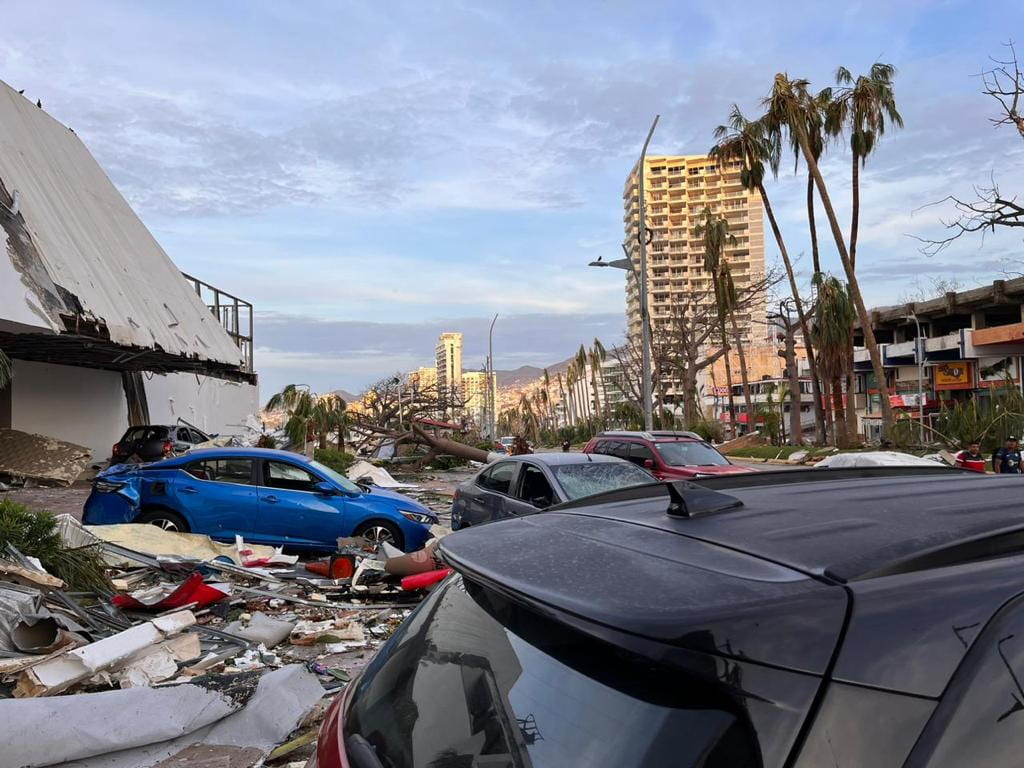Hurricane Otis must not be forgotten
By Monica Ledezma, on 1 February 2024

The weekend started as any other in Acapulco, the sun shining was over the bay. I was with my family staying at a well-known hotel on the coast. A diving session was booked for the coming Wednesday. There was no hint or warning of any worrying weather.
The Disaster
The spots of rain during the day didn’t worry us, but that soon changed when a news broadcast alerted us to an approaching tropical storm. We did not receive any specific preparation instructions during the day.
The hurricane was expected to reach the shore by 5-6 am the next day. Airplanes continued to land in Acapulco throughout the day. Acapulco was crowding with more than 50% of the city occupied: it was hosting the 35th International Mining Convention that week with the opening ceremony scheduled at 6pm on that day, with no restrictions.
When my family and I came back from dinner, we noticed that the room windows were covered with packaging tape and our personal belongings kept near the balcony were safely stored inside the room. We received a letter from the hotel saying that we should stay in the room announcing that the next day the hotel services would remain open. We started preparing for the hurricane by going to the convenience store and buying water and food.
At 11pm we heard the heavy rains and ferocious winds at 270 km/hr ravaging everything on its way. Furniture was flying through the air and falling into swimming pools and the sea. We could hear the winds peeling off the glass of almost every hotel.
The building moved as if it was an earthquake, the ceiling and walls which were not made of concrete fell to the floor. We had been told to stay in the room, but it was falling apart around us, so we moved to the corridor instead. Suddenly we heard some voices of a couple of men directing us to the basement where the rest of the hotel guests were heading.
We went down 12 floors to the basement and stayed there for more than 7 hours with the rest of the guests under emergency lighting with no water or electricity. It was warm and all guests and hotel staff were focused on helping and surviving.

The Aftermath
The worst of it had passed by 6 am, but the picture outside was exactly like what I had seen in the movies. There was destruction everywhere. Luckily for us, our cars were safely parked far away from the shore, but the roads were blocked by all the debris. Through shattered glass, fallen palm trees, and even bits of steel structures, it took us 6 hours to find a way to go out from Acapulco and back to Mexico City. There was no sign of any authorities, nor any support from the army or navy, nobody to help in the streets. No power supply, no gas. We were making decisions ourselves to the best of our capacity. Stores soon started to be vandalized.
For the next 6 hours, we were stuck on the highway which was partially damaged. Only then we saw the Army trucks on their way to Acapulco—now sharing the only available highway with civilians trying to get out—15 hours after the disaster happened.
A sequence of neglected communication
At 16:18 on Sunday, October 22nd, official information by Proteccion Civil warned that a “tropical storm” was located in the southeast of Acapulco, far away from our wildest imagination. Early on Tuesday, the state governor stated that the tropical storm had turned into hurricane category 1. She insisted that adequate attention was taking place to safeguard the population’s well-being for its arrival early on Wednesday. 631 refugee centers were habilitated to support 137,000 people.
At least 10 hours before the hurricane, the National Center for Hurricanes in the US warned about the risk and potential catastrophic events. Only at 8 pm, the president finally acknowledged what US authorities have been repeatedly highlighting as a Category 4 hurricane, but it was too late now to take any protective measures.
Otis is, to date, the highest category hurricane recorded at any station of the National Tidal Service. The possibility that climate change encouraged Otis to transform from a tropical storm into a hurricane highlights the importance of adapting our infrastructure to this change.
The disaster happened in hours, the wind and rain swept everything away, and we suddenly felt the vulnerability and lack of support and guidance. We were fortunate enough to get to the shelter but we will always remember the images of the windows shattering, the ceiling crumbling, and how close we were to falling from the 10th floor balcony. We were just not prepared for it. The government authorities decided to neglect the fact that it was happening, underestimating its strength.
I still have these questions in my mind: what would it take if the authorities had told us what to do, where to go, and warned us how strong this would be? What would have happened if the Army and Navy forces had been there since the first alert came in? Why did the government ignore and underestimate the warnings? I hope to get an answer someday.
Monica Ledezma completed the MSc in Global Health and Development at UCL in 2020/21. Monica has worked at Roche since 2016 in the Diabetes Care Division.
The views expressed in this blog are those of the author.
Read more IRDR Blogs
Follow IRDR on Twitter @UCLIRDR
 Close
Close


